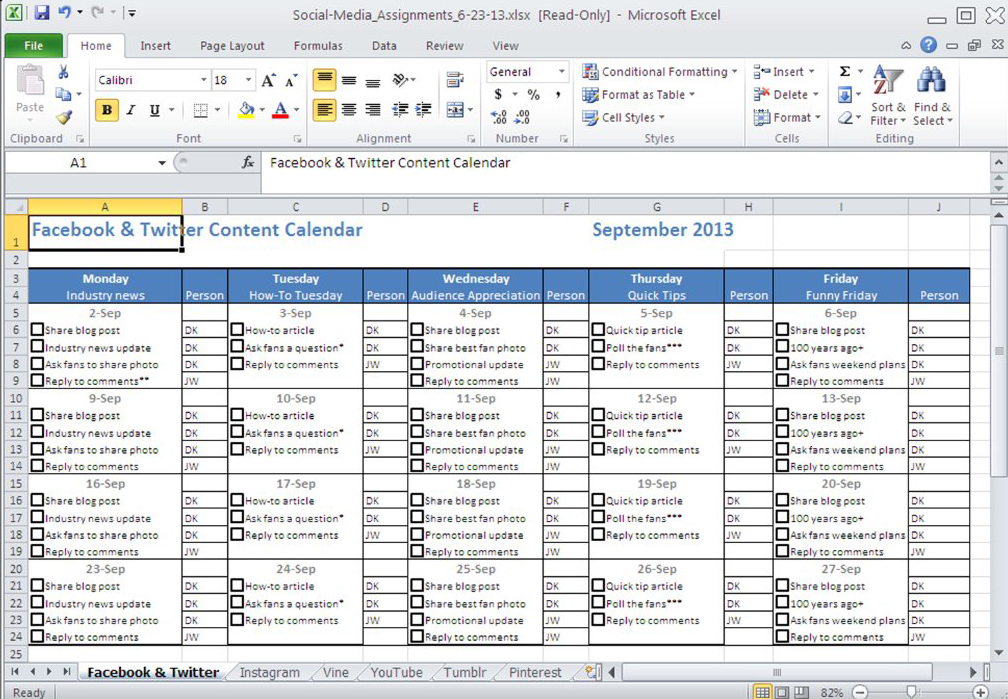Special Reports
It’s (Mostly) in the Planning

Getting to the next level with social media
You wouldn’t launch a serious marketing campaign without significant forethought and planning (right?). The same holds for your social media marketing efforts.
Social media marketing requires all the organization needed for any successful marketing effort. In fact, social media marketing requires a bit more in the way of organization, since it is ongoing and constantly evolving.
This article assumes you’ve given serious thought to your social marketing strategies and goals and the need to measure your social media activity and ROI through metrics. These all have an impact on how your social efforts are organized, of course; you will do different things at different times to drive ticket sales versus promote the talk show appearance of an artist. Nonetheless, we will focus solely on organizing your social media efforts to give you the best chance for achieving your goals.
Not Rocket Science
 Once you approach social media marketing as similar to other projects, planning your organization’s time and resources becomes fairly straightforward. Many public groups have created detailed strategy and organization manuals to facilitate social media activity and ensure it is accomplished with the best chance for success. These groups range from the U.S. Air Force and Navy to the Ohio Farm Bureau. Train your staff (or yourself) Training involves a combination of learning the various platforms and learning the approach you want your organization to take on the social networks.
Once you approach social media marketing as similar to other projects, planning your organization’s time and resources becomes fairly straightforward. Many public groups have created detailed strategy and organization manuals to facilitate social media activity and ensure it is accomplished with the best chance for success. These groups range from the U.S. Air Force and Navy to the Ohio Farm Bureau. Train your staff (or yourself) Training involves a combination of learning the various platforms and learning the approach you want your organization to take on the social networks.
Train your staff (or yourself)
Training involves a combination of learning the various platforms and learning the approach you want your organization to take on the social networks.
Pick three or four platforms and make certain anyone responsible for your social media activity is proficient on them; don’t expand to other platforms until they are. “Proficient” means more than learning to post—it also means understanding the metrics, how to change the background graphics, add apps, block users, etc.
What will be the “voice” of your social presence? Casual or formal? Third person or first person? Humorous and irreverent or straight and serious? Long and involved (not recommended) or short and pithy? A consistent approach to your minute-to-minute social media activities is not only key to good branding, it’s also critical to efficiency and productivity.
Next, post to all your social platforms with the same content. Well, not precisely the same content. At the same time as you’re posting to Facebook, post a tweet-appropriate version of the same content to Twitter and a graphic related to that same content on Pinterest—all at more-or-less the same time. This will help you think through the postings to make them fit the audience on each network. It will also have a beneficial effect on the search engines and, since people’s accounts are often cross-mingled among networks, the impact to your audiences will be greater.
Consider your work plan
Your work plan answers the basic questions for conducting your social media marketing activity:
- Who is going to do the work? Just as you wouldn’t expect to sit alone in a corner during a party, social media requires ongoing interaction and effort. Designate one person to be thesocial media “lead.” That person has the responsibility to be on top of the interactions. The responsibility can even be rotated among people on a schedule, but one person should always have the lead.
- How much time each day or week will be spent on social media? Creating content and postings takes time and it’s easy to let other tasks get in the way. Assume an hour or so a day for tending to your social media output. Try to make it happen every day instead of ganging it up for a single day or two during the week.
- When during the day or week will you do it? Dive into the particular social media pools like Twitter or Instagram at the same time each day. It will quickly become part of your workday routine at the same time increasing audience activity.
- What will get posted? We know that using social media strictly as a one-way promotional bulletin board doesn’t work and that engaging in conversations, running contests, retweeting, engaging your influencers, etc. are key. But you still need to quantify. For instance, you should send four retweets for every tweet you originate; favorite at least six Facebook posts each day, etc. And are you tracking all that?

Also, the “lead” person should be monitoring the activity in your social media channels during the day and possibly also the early evening. The more quickly you can respond to what your audience is doing in your social feeds, the more your will generate increased audience activity, thereby creating fertile ground for accomplishing your goals. In addition, customer service issues will arise—those become very public on social networks—and you’ll want to deal with those quickly.
Pass the baton
It’s entirely possible that you’ll have one person designated as the social media maven (perhaps you…). But in case there is more than one, be sure there is ample communication as one person’s shift ends and another begins.
Remember, social media is very public and missteps get noticed. Create a standard procedure to bring the incoming person up to speed on any issues happening in your social space: customer service communications, recently posted items, retweets in progress, influencer activity, content to be posted during the upcoming shift, etc.

WHO'S BLOGGING

Law and Disorder by GG Arts Law
Career Advice by Legendary Manager Edna Landau
An American in Paris by Frank Cadenhead





 FEATURED JOBS
FEATURED JOBS

 RENT A PHOTO
RENT A PHOTO


